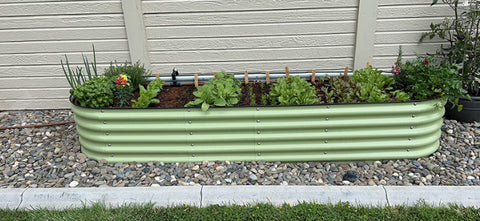Knowledge from Olle Garden Bed: How To Make Plants Recover From Cold Damage
With the arrival of winter weather, your plants face the risk of cold damage. If you put any tropical or sensitive plants in a cold place in the past few months, you may notice some signs of health decline. Although it is a common mistake to expose plants to the cold when they are not cold tolerant, you can take several steps to bring them back from the edge. Read here are some things that you should know when It comes to Olle Garden Beds!

Signs of cold damage
Although you may leave sensitive plants outdoors in the cold season, the cold damage may not always be the problem. Your plants may suffer from diseases, pests or excessive watering. Fortunately, there are several ways to determine whether chilling injury is the culprit of plant decline.
If the temperature of your plant outside is not appropriate or close to the ventilation window, it may still be OK. However, if you notice that the leaves wither or droop, have brown or black spots on the leaves, and split into stems or trunks, these are signs of cold damage. In this case, it is essential to take the correct steps to reverse the cold damage.
Some varieties are more difficult to recover from cold injury than others. Plants susceptible to frost include cacti, succulent plants and begonia. For the same reason, the degree of damage may mean that your plant will not come back, but it is always worth a try.
Tools you need
Are you ready to save some plants! You need to collect some different tools to implement it.
Warm indoor location
Sprinkler
Clean water
Gardening gloves
Disinfection trimming scissors
How to make plants recover from cold damage
Now that you know how to identify cold damage and have the right tools, please learn the step-by-step instructions for bringing your factory back to life.
Step 1: Move the plants indoors and water them
If possible, bring all potted plants indoors. Otherwise, move them to a warm place, such as a garage or greenhouse. Do not place them near heat sources, such as fireplaces or radiators, or direct sunlight for 48 hours. Although this seems to be a good idea of "warming plants", it may only shock them and make recovery difficult.
Too much light and high temperature will lead to the loss of water in transpiration, make plants dehydrate and destroy their ability to absorb water. If your plants are underground, you can still take preventive measures to protect them from the cold, such as covering them or covering them with burlap.
You should also water the plants brought into the room immediately to replenish water. Frost will absorb water from leaves, resulting in insufficient watering of plants. Wait until the cold passes to water your outdoor plants.
Step 2: Be patient before pruning
Although you may want to remove all dead leaves immediately, you'd better leave it and wait. Of course, you can remove the fallen branches or leaves.
If you trim damaged tissues while the plants are still outdoors, you will expose the fragile and healthy parts to the cold environment. Instead, let your plants recover for a few months, or wait until the weather gets warmer in spring. Then, you can use a sharp and clean trimming scissors to carefully cut off all dead corners.
Step 3: Avoid fertilization
If you want your plants to recover, patience is the key. Cold damage can lead to stress, and plants need time to heal and regenerate. Premature fertilization will force plants to focus on producing new buds, which means that leaves and stems will not have adequate nutrients, time or energy to recover properly.

In addition, if your plants are still outside, the new growth may be damaged by the cool temperature. Fertilization should only be started after the dead leaves are trimmed and the plants look healthy.
If the plant does not start growing again in spring, please check whether the root is rotten. If they are brown and mushy, you can remove the dead roots and replant what you can save. If possible, you can also cut some healthy leaves and breed plants.
Prevent cold damage in the future
Seedlings and immature plants are most vulnerable to cold damage, so they should always be at the top of your list so that they can be brought indoors or stored in a protective cold rack. When overwintering plants, you can choose to build a cold frame or support system to support the protective tarpaulin. In this way, heavy snow and ice will not crush your precious plants.
In addition, ensure that plants are as close to the ground as possible and cover the soil to provide insulation and warmth. Use soft and breathable fabrics, such as sheets, towels or burlap, to protect your plants from the impact of winter wind and snow. Don't forget to water plants before frost to provide warmth and insulation.
If you often forget to protect plants or bring them indoors, please look for cold-resistant plants. Rhizome vegetables, colorful berry shrubs and flowering perennial plants will survive in cool temperatures. Always carry out research to ensure that the plants you pick can survive in your area!
Bring them back!
Whether the unexpected cold front is rolling in, or you accidentally expose the plants to the cold weather this winter, you can restore them by taking them indoors, watering and waiting patiently. In the future, please pay attention to the weather forecast, bring plants into the room in advance, and apply appropriate coverings on the trees, shrubs and plants outside the winter.
